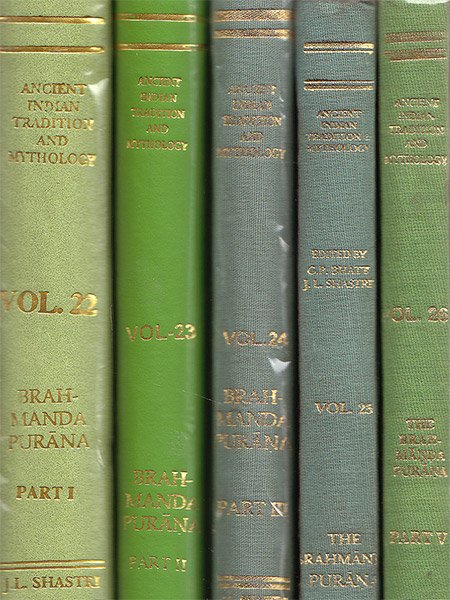The Brahmanda Purana
by G.V. Tagare | 1958 | 319,243 words | ISBN-10: 8120838246 | ISBN-13: 9788120838246
This page describes the description of nimi dynasty (vamsha) which is Chapter 64 of the English translation of the Brahmanda Purana: one of the oldest puranas including common Puranic elements such as cosmogony, genealogy, ethics, geography and yoga. Traditionally, the Brahmandapurana is said to consist of 12,000 verses metrical Sanskrit verses.
Chapter 64 - The description of Nimi dynasty (vaṃśa)
Note: This chapter corresponds to chapter 89 of Vā.P.
Sūta said:—
1-2. Understand (the details of) the line of Nimi who was the younger brother of Vikukṣi. He built a city well-known by the name Jayanta, comparable to the city of the Devas. (It was) near the hermitage of Gautama. It was in his family that there was born the excellent king Janaka.
3. Ikṣvāku of profound brilliance had a son named Nimi, a highly pious soul wḥc was saluted by all living beings and who became a great king.
4-5. On account of the curse of Vasiṣṭha, he became Videha (devoid of physical body). His son named Mithi was produced in the course of three Parvans. This king of great fame was born of Araṇi (the wood from which fire is kindled for sacrificial purpose) while it was being churned. He is well-known by the name Mithi. He became Janaka due to the act of Janana (procreation in such a way).
6. Mithi was indeed a king of great prowess. It is from h is name that this capital city became known as Mithilā[1]. Another name of this king was Janaka and Janaka’s successor was Udāvasu.
7. The virtuous-souled son Nandivardhana was born of Udāvasu. The valorous and virtuous son named Suketu was born of Nandivardhana.
8. The noble-souled son of great strength, Devarāta was born of Suketu. The pious-souled son well known as Bṛhaduktha was born of Devarāta.
9. Mahāvīra was the valorous son of Bṛhaduktha. Dhṛtimān was the son of Mahāvīrya and Sudhṛti was his son.
10. Dhṛṣṭaketu, the suppressor of his enemies, was the noble-souled son of Sudhṛti. The son of Dhṛṣṭaketu was well-known by the name Haryaśva.
11. Maru was the son of Haryaśva. Pratimbaka[2] was the son of Maru. It is remembered that the righteous-souled king Kīrtiratha was the son of Pratimbaka.
12. The son of Kīrtiratha is also known by the name Devamīḍha. Vibudha was the son of Devamīḍha. Mahādhṛti was the son of Vibudha.
13. The son of Mahādhṛti was the valorous king Kīrtirāta. The learned son of Kīrtirāta was well-known by the name Mahāroman.
14. The famous king Svarṇaromā was born of Mahāromā. The son of Svarṇaromā named Hrasvaromā became a king.
15. The learned son of Hrasvaromā was well-known as Sīradhvaja. Sītā of great reputation, rose out of the ground when that king ploughed it.
16-18. She was the chaste queen of Rāma. She was a lady of good holy rites and vow of self-restraint.
Vaiśampāyana enquired:—
How was Sītā of great reputation raised up from the ground on being ploughed. What for did the king plough? Where was the field?
Sūta replied:
The site of the sacrificial fire in the horse-sacrifice of the noble-souled king was being ploughed energetically in accordance with the injunction. She rose up from it. The Prince of Mithilā named Bhānumān was the younger son of Sīradhvaja.
19. His brother was Kuśadhvaja. He was the king and overlord of Kāśī. (Saṃkāśya Pradyumna was the valorous son of Bhānumān.
20. Muni was his son. It is remembered that Ūrjavaha was born of him. Sanadvāja was born of Ūrjavaha and Śakuni was his son.
21. Svāgata was the son of Śakuni.[3] It is proclaimed that Suvarcas was his son. His heir was Sutoya[4] and his son was Suśruta.
22. Jaya was the son of Suśruta. Vijaya was the son of Jaya. Kratu[5] was the son of Vijaya. Sunaya is remembered as the son of Kratu.
23. Vītahavya was born of Sunayā. Dhṛti was the son of Vītahavya. Bahulāśva was born of Dhṛti. Kṛti[6] was the son of Bahulāśva.
24. The line of the noble-souled scions of the family of Janaka came to a close with him. Thus the Maithilas have been recounted. Understand the line of Soma now.
Footnotes and references:
[1]:
Modern Tirhut, also called Janakpur, in Darbhaṅgā Dist. Bihar.
[2]:
Pargiter records Pratīndhaka for this (AIHT. p. 147)
[3]:
It appears our text jumped twelve generations downwards and declared Svāgata as the son of Śakuni. AIHT, p. 144.
[4]:
Pargiter records the name Śruta for Sutoya of our text.
[5]:
Ṛta according to Pargiter—ibid.
[6]:
Kṛtakṣaṇa in AIHT, p. 149.
